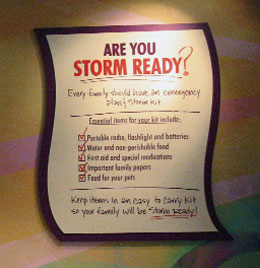|
Storm clouds gathering
New feature at Epcot shows what storms can do
By Michael J. Moody, MBA, ARM
Hurricane season is close at hand. Some home owners will look to their local agents and brokers for relevant information about hurricane mitigation procedures; however, there are other sources of this information as well. One less obvious source is at Walt Disney World. Recently, Disney and a host of co-sponsors opened a new feature at the Disney theme park Epcot called “StormStruck.”
Housed in the Innoventions East building in Epcot’s Future World section, the exhibit is an interactive, educational weather experience that allows guests to experience a simulated windstorm. They can also learn a variety of safe building techniques. And take it from someone who has been through half a dozen hurricanes, it is very believable, even when you know it is a simulation. As always, the Disney people plan a few surprises.
The nonprofit Federal Alliance for Safe Homes, Inc. (FLASH), unveiled the exhibit in late April 2009. StormStruck, in essence, is a tale of two homes and how they survive the effects of a severe storm. The new exhibit also has a feature known as the “Flood Wall” which discusses the important facts about flooding, including the best way for home owners to prepare for floods and protect themselves from costly flood damage. FLASH officials note that it is difficult to discuss severe weather without talking about floods. They point out that flooding is the nation’s most common and costly natural disaster.
High water mark
Also on hand at the opening of the exhibit was Edward Connor, Acting Federal Insurance Administrator for FEMA, who is responsible for the National Flood Insurance Program (NFIP). Connor pointed out that while hurricane season is a great time to focus on the flooding potential, in fact, “flooding can occur anytime during the year.”
And, as Connor notes, “most homeowners policies do not cover flood.” He says that first it is important to know exactly what a flood is. According to FEMA, a flood is a general and temporary condition where two or more acres of normally dry land or two or more properties are inundated by water or mudflow. And while flooding is most associated with hurricanes, Connor indicates that “anywhere it rains, it can flood.” Many conditions in addition to the actual hurricanes can result in flooding:
• Heavy rains can overwhelm drainage systems and result in flooding.
• Storm surges are the water that is pushed towards the shore by the strong winds of storms; and these wind-driven waves can cause severe flooding in coastal areas. High tide can be extremely dangerous and destructive when combined with a storm surge.
• Inland flooding can result from hurricanes and other storms, powerful systems that can travel inland and bring wind and heavy rains.
Flooding in the United States became such a problem that in 1968, Congress created the NFIP to help provide a means for property owners to financially protect themselves. The program offers flood insurance to home owners, renters, and business owners if their communities participate in the program. Participating communities must agree to adopt and enforce ordinances that meet or exceed FEMA requirements for reducing the risk of flooding. According to Connor, today there are about 20,900 participating communities, and “this represents the bulk of the nation.” However, what concerns Connor is that participation by individual home owners and business owners in the flood insurance program today “is alarmingly low.”
Importance of communications
Another participant at the opening of the StormStruck exhibit was Max Mayfield. The former director of the National Hurricane Center, Mayfield is now involved with a new venture, America’s Emergency Network (AEN). Emergency communication has been a hot button issue in Washington, D.C., since the terrorist attacks of 9/11. Many believed that better communications would follow after the shortcomings noted from 9/11; however, they would be wrong. Because in the aftermath of Hurricane Katrina, emergency workers also noted many of the same gaps in their communication systems that were endured during the 9/11 period.
The fact is that during a crisis, U.S. government officials have to rely on the same news and information system that serves us every day. The problem is that these systems’ technical and operational infrastructures were never designed to operate under the strain of a disaster. What we have learned is that the emergency requirements that communications be immediate, clear, and cover all-important issues and affected geographic areas cannot be fulfilled by our traditional news-gathering framework. Currently, there is no standardized, dedicated and secure distribution infrastructure that overcomes these shortcomings.
AEN is attempting to fill this gap. The network collects emergency bulletins and video feeds and stores the information in a central database, and distributes it to the public and the media. However, there is more than just distributing the information; people have to know to go online or tune in, and this is the role that AEN is trying to fill. Its primary goal is to make certain that every emergency manager, whether at national, state or local level, has a reliable means to share vital information with the public, the media and other governmental agencies. AEN is a satellite-based system that is designed to continue to work after a disaster when power lines, phone lines, cell phone tower and terrestrial Internet systems are knocked out.
Working in conjunction with AlertFM, AEN is rapidly expanding through Florida and eventually the nation. After receiving widespread praise during Tropical Storm Fay and Hurricanes Gustav, Hanna and Ike, the system was able to stream real-time news briefings from state and local operations centers. AEN is deploying a national instantaneous alerting system that is not dependent on phone lines or cell phone towers, thus bridging the information gap that occurs after almost every major disaster. Mayfield, who is a senior executive vice president-government relations at AEN, notes that they have made a meaningful contribution in Florida and look forward to spreading their network across the United States.
Conclusion
As was noted above, FEMA’s Connor states that “participation in the flood insurance program today is alarmingly low.” Some surmise that people may be counting on the government to bail them out in the event of a disastrous flood. But, as Connor points out, “there may be alternatives such as disaster loans, but these have to be paid off with interest. Only flood insurance protects the home owner’s residence and its contents.
Agents and brokers must remember that flood losses can occur anywhere. And while those of us who are in close proximity to the Atlantic Ocean are acutely aware of the potential for flooding, this potential is everywhere. As we have all realized, flood is a risk that is excluded from the normal homeowners policy and thus needs to be purchased separately. The National Flood Insurance Program is the perfect vehicle for this purpose. And with hurricane season approaching, now is the time to talk to clients about the need. Remember that coverage does not start until 30 days after application.
StormStruck has done an excellent job of showing the public some of the effects of storms; however, it is up to agents and brokers to make certain that their clients are properly protected. Pricing of the coverage varies by the degree of risk, so the dwelling in low-risk flood areas has minimal costs associated with it. Make sure that you review the advantages of flood coverage with your clients.
|
|
| |
 |
| |
The new exhibit, sponsored by FLASH, has a feature known as the “Flood Wall” which discusses the important facts about flooding, including the best way for home owners to prepare for floods. |
| |
 |
| |
StormStruck has done an excellent job of showing the public some of the effects of storms; however, it is up to agents and brokers to make certain that their clients are properly protected. |
|